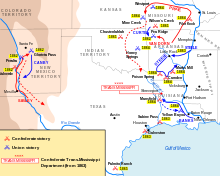


The Trans-Mississippi Department was a geographical subdivision of the Confederate States Army comprising Arkansas, Missouri, Texas, western Louisiana, Arizona Territory and the Indian Territory; i.e. all of the Confederacy west of the Mississippi River. It was the last military department to surrender to United States forces in 1865.
History
[edit]The Trans-Mississippi Department was established on May 26, 1862, at Little Rock, Arkansas. It absorbed the previously established Trans-Mississippi District (Department Number Two) which had been organized on January 10, 1862, to include the Indian Territory, Missouri, Arkansas (except for the country east of St. Francis County, Arkansas, to Scott County), Missouri, and that part of Louisiana north of the Red river. The Trans-Mississippi Department had its headquarters at Shreveport, Louisiana, and Houston, Texas. It was responsible for the Confederate theater of operations west of the Mississippi. Its forces were sometimes referred to as "Army of the Southwest" and, as a result of being largely cut off from the Confederate government in Richmond late in the War, became popularly known as "Kirby-Smithdom".[1]
Commanding generals
[edit]- Brigadier-General Paul O. Hébert (May 26, 1862 – June 20, 1862)
- Major-General John B. Magruder (assigned June 20, 1862, but did not accept)
- Major-General Thomas C. Hindman (June 20, 1862 – July 16, 1862)
- Lieutenant-General Theophilus H. Holmes (July 30, 1862 – February 9, 1863)
- General E. Kirby Smith (March 7, 1863 – April 19, 1865)
- Lieutenant-General Simon Bolivar Buckner (April 19, 1865 – April 22, 1865)
- General E. Kirby Smith (April 22, 1865 – May 26, 1865)
References
[edit]- ^ Jones, Terry (2002). Historical Dictionary of the Civil War. Lanham, Md.: Scarecrow Press. p. 785. ISBN 9780810841123.
Further reading
[edit]- Baker, T. Lindsay, ed. (2007). "Chapter 6: Collapse of the Confederacy". Confederate Guerrilla: The Civil War Memoir of Joseph M. Bailey. Civil War in the West. Fayetteville: The University of Arkansas Press. ISBN 978-1-55728-838-7. OCLC 85018566. OL 8598848M.
Well, that’s interesting to know that Psilotum nudum are known as whisk ferns. Psilotum nudum is the commoner species of the two. While the P. flaccidum is a rare species and is found in the tropical islands. Both the species are usually epiphytic in habit and grow upon tree ferns. These species may also be terrestrial and grow in humus or in the crevices of the rocks.
View the detailed Guide of Psilotum nudum: Detailed Study Of Psilotum Nudum (Whisk Fern), Classification, Anatomy, Reproduction